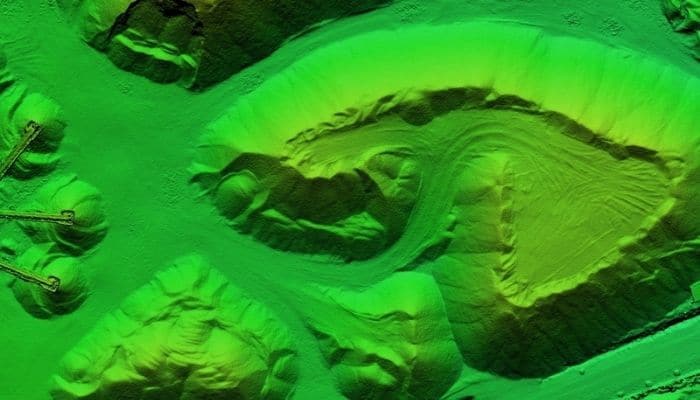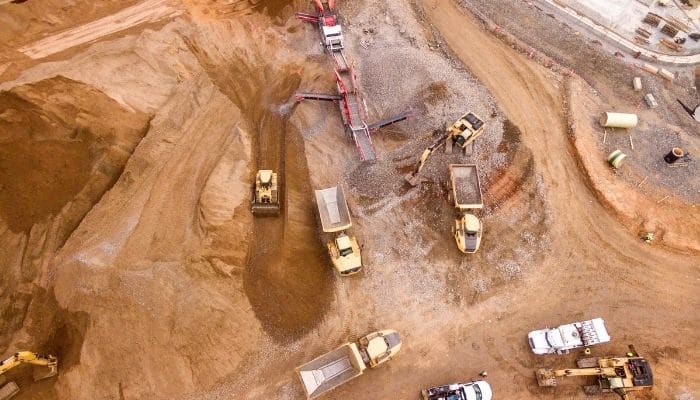Drones are revolutionizing the way the mining industry operates. Drones are used to optimize a variety of mining activities, including surveying, mapping, inspection, and assisting with safety and security. Drone technology is used as a way to reduce costs, increase efficiency, and improve safety in the mining industry. Due to the great benefits of drones in mining, more and more companies are utilizing drone technology in their workflows.
This is especially true in places like Australia and the African continent, where over 200 mining companies were surveyed. global data And it turns out that the majority of these companies are adopting drone technology, and we’re seeing improvements in many areas of their operations.
Of course, mines and quarries are inherently dangerous workplaces, so the most important benefit of using drones in mines is the reduced health risks for personnel.
Use of drones in mining
Advances in technology have allowed drones to be used in a variety of ways in the mining industry. One of the main reasons for the increased use of drones in commercial applications is their ability to retrieve data very quickly.
This makes drones easier to operate and deploy, and allows them to acquire data on a regular basis, offering distinct advantages over other ground-based data acquisition methods, leading to improved decision-making and faster workflows. .
One of the primary use cases for drones is stockpile management. Calculating exact levels of stockpile and tracking them can be a time-consuming task, results are not always accurate, and lead to costly waste.
But with drones, precise stockpile readings can be calculated very quickly and regularly, allowing businesses to track what is being removed and how much it is costing.
Drones are also used for mining exploration. Drones can easily capture high-resolution images, which can be processed by photogrammetry software to create high-quality orthomosaic his maps and 3D models. These maps can be used to analyze the local topography and identify areas of interest.
Another use for drones is surveillance and security. Mining sites have heavy equipment of great value and are often targeted by criminal gangs. Drones can be used as an additional layer of security to help deter criminal activity.
Drone-in-a-box solutions like those offered by Percepto, Easy Aerial and DJI are perfect for surveillance and security tasks. These drones can be scheduled to perform security patrols at specific times and can also be triggered to take off automatically in the event of a perimeter breach.
7 benefits of using drones in mines
A digital elevation model of the mining site.Digital assets obtained by processing images taken by drones
Traditional methods of performing surveys to map and model mining sites require a lot of equipment and workers have to navigate hazardous terrain to collect data for this task. Surveying for mapping and 3D modeling Photogrammetry.
Photogrammetry is the science and technology of obtaining accurate data about the physical world through photography. Aerial photogrammetry is performed via manned aircraft or drones. However, drones are proving to be a faster, more efficient, and cheaper method, which is why drones are a more popular choice. Alternatively, LiDAR equipment is expensive and requires a little more expertise to analyze the data, which may not be suitable for many surveying requirements.
Aerial photographs collected by drones are processed in a special way. photogrammetry software Some of the deliverables include 2D maps, digital elevation models, digital terrain models, and 3D cloud points, all with accurate geospatial measurements.
Whether it’s data for exploring potential mining sites or collecting volumetric measurements for stockpile and inventory management, drones can be used for photogrammetry without compromising data integrity. provides an easier and more efficient way to collect data through Another advantage of drone surveys is that they are cheaper than manned aerial surveys, so they can be performed more frequently, allowing for a more accurate picture of production progress and stockpiling of year-end financial reports. is.
2. Stockpile management and inventory management

Digital elevation models for stockpiles and aggregates
Stockpiles are irregular in nature and calculating exact amounts is difficult with ground-based methods and is also a dangerous and time-consuming process. Most are eliminated, making the process of obtaining stockpile data much more efficient and, more importantly, safer for workers. It can be run to more fully represent the amount of material available, what can be extracted, and reduce depreciation that is better reflected in year-end financial results.
3. Optimization of transportation roads
Aerial drone imagery allows site managers to frequently inspect and monitor haul road conditions, helping maintain haul roads for smoother transit of goods. Using high-definition drone imagery, engineers can analyze current routes and see how routes can be optimized for greater efficiencies that help reduce fuel costs and save the company money. This includes quickly identifying haul road damage so that it can be repaired as quickly as possible with minimal disruption to transportation operations. Using drones to maintain and optimize haul road management eliminates the need to physically inspect roads on foot, reducing the risk of harm to company personnel.
4. Improved mining safety
This is the main advantage of using drones for mining operations. This is a dangerous industry that causes many lives and thousands of injuries each year. The use of drones in mining can help improve worker safety and eliminate unnecessary risks to their health. From the initial exploration to acquiring survey data for pre- and post-blast analysis, drones allow operators to avoid many dangerous situations and maintain the highest standards of work, while maintaining their own You can protect your co-workers from harm.
5. Regular monitoring of tailing dams
Tailings are what remains after successful extraction of valuable minerals and metals from rock ores. This waste, usually a slurry, accumulates on embankments to form dams, which, if poorly constructed, pose a significant risk to people living near mining areas and to the environment. Drones will allow site managers to regularly inspect tailings dams without endangering workers and respond quickly if any issues with the dam’s structural integrity are identified.
6. Drones used for inspections in underground mines
Underground mines can be thoroughly inspected and mapped using drones to determine structurally completeness whether they can be safely penetrated and to better understand what can be extracted from the remaining ore. increase. It’s like an underground cave, analyzing the stops created after blowing it up to see how stable they are, what areas need more support, and extract to keep the area stable. You can determine the amount of backfill required later. Currently, there is only one drone available underground for mining analysis, and that is the Elios 2. See below for details.
7. Cost savings
Health and safety are the biggest and most important reasons why many mining companies are integrating drones into their workflows. Reducing costs and increasing overall revenue is another key factor in deciding whether to invest in drone technology. So far, the evidence points to the fact that drone technology is helping businesses reduce costs and increase efficiency, with an overall net positive return on investment.
The best drones to use in mining
A few years ago, there weren’t many drones available for industrial use, but now that drone technology has advanced, there are quite a few options to choose from.
Drones with good specs, exceptional cameras and flight times are suitable for mining use. Some jobs require a high degree of data accuracy, such as in mapping and 3D modeling. This is done through a process called photogrammetry. Photogrammetry is the science of obtaining data about areas of land through images. The data captured by the drones are processed by special photogrammetry software and transformed into various types of digital maps and 3D models for easy analysis.
Here are five drones that are ideal for mining applications such as surveying, mapping, 3D modeling, surveillance, and inspection.
1. DJI Phantom 4 Pro RTK
This is the most popular drone for commercial purposes, easy to operate and comes with some solid features. The drone is equipped with a 1-inch 20MP sensor for high-resolution image data, an RTK module for centimeter-level accuracy, an obstacle avoidance system, and a flight time of 30 minutes.
3. DJI Matrice 300 RTK
It is one of the most advanced commercial drones on the market, a well-built drone with robust construction with an IP45 rating that allows it to operate in extreme weather conditions. Compatible with multiple payloads, it can carry up to 3 cameras with a total maximum weight of 2.7kg. It has an RTK module for survey-grade accuracy and a flight time of up to 55 minutes depending on the type of payload it carries. Other features include an AI health management system, omnidirectional obstacle sensing, and an advanced redundancy system so that system failures do not compromise flight missions.
3. WingtraOne GEN II Drone
A fixed-wing drone with vertical take-off and landing capabilities and many impressive features. The drone he he is built to MIL-STD-810 standards and has an IP68 rating so it can operate in the harshest weather conditions. It has multiple payload capabilities, this includes a full-frame Sony RX1R II camera with his 42MP sensor, along with his PPK GPS correction technology integrated into the drone, for sub-centimeter level surveying. Provides grade accuracy.
4. SenseFly eBee X
One of the original drones for surveying and mapping, the eBee X comes with an integrated RTK/PPK system and, depending on its payload, has a maximum flight time of 90 minutes. It can fly in winds of up to 28 mph and is compatible with multiple cameras. This is the perfect drone for mapping, monitoring and inspecting rough terrain and hard-to-reach places.
7. Elios 3
The latest drone from Flyability, the Elios 3 comes with some significant upgrades over its predecessor, the most impressive being the addition of a LiDAR sensor. is 12 minutes, but with the LiDAR sensor attached this drops to about 9 minutes. The Elios 3 is designed to operate in confined spaces and comes with a carbon fiber cage that minimizes damage in the event of a crash.
6. Elios 2
The Elios 2 is a rugged indoor drone optimized for commercial applications in confined spaces. Elios 2 uses a 4K and infrared camera to capture image data in hard-to-access locations. The drone isn’t too big and is protected by a protective cage so it won’t get damaged if it hits an object. The drone allows you to see clearly even in dusty areas, and powerful 10000 lumen illumination allows you to inspect the darkest areas. This drone has many uses, especially for mapping and inspection of underground mines where it can operate without the need for a GNSS receiver.
